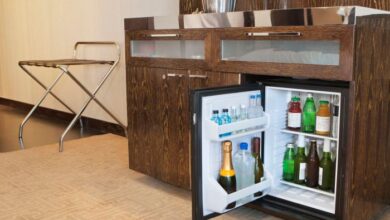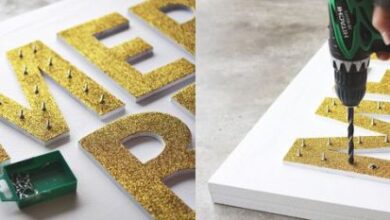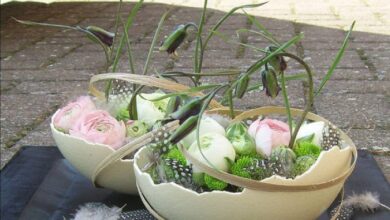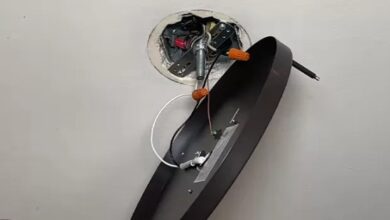
How to do board and batten on a staircase? It might sound like a daunting task, but with the right tools, materials, and a bit of patience, you can transform your ordinary staircase into a stunning architectural feature. Board and batten, a classic design element, adds a touch of elegance and warmth to any space, and when applied to a staircase, it creates a unique and inviting focal point.
Let’s embark on this DIY adventure and discover the steps to achieve a beautiful and functional board and batten staircase.
This project involves planning, preparation, and careful execution. From choosing the right wood and tools to measuring and cutting the materials, each step plays a crucial role in ensuring a successful outcome. We’ll delve into the details of each stage, providing clear instructions and tips to guide you through the process.
So, roll up your sleeves, gather your tools, and let’s get started on creating a staircase that will be the envy of your neighborhood.
Installing the Battens: How To Do Board And Batten On A Staircase
Now that your staircase is prepped and ready, it’s time to install the battens. This is the part where your staircase starts to take shape and gain that classic board and batten look.
Attaching Battens to the Staircase, How to do board and batten on a staircase
Start by measuring and marking the location of the first batten on the riser. Remember to account for the spacing you’ve chosen between the battens. Typically, spacing is between 4-8 inches, but you can adjust it based on your personal preference and the size of your staircase.
Once you’ve marked the location, use a level to ensure the batten is perfectly straight. This is crucial for achieving a clean and professional look.
Cutting and Installing Battens Around Corners and Curves
Corners and curves present a unique challenge when installing battens. Here’s how to handle them:
- Cutting for Corners:Measure the angle of the corner and use a miter saw to cut the batten at a 45-degree angle. This ensures a seamless fit and a clean transition.
- Installing Around Curves:For curves, you’ll need to cut the batten into smaller sections. Start by measuring the curve and marking the batten for each section. Use a jigsaw to cut the batten to the desired shape.
Creating a Smooth and Even Surface
You want the battens to sit flush against the staircase. Shims are your best friend here. Place shims behind the batten where necessary to level it out and ensure it sits flush against the staircase. For larger gaps, you may need to use multiple shims or consider using a piece of wood to fill the space.
Securing the Battens
You have a few options for securing the battens:
- Nailing:This is a traditional method and works well for most staircases. Use finishing nails, which are smaller and less noticeable than regular nails.
- Screwing:Screws provide a more secure hold and are less likely to pull out over time. Use countersinking screws to ensure the screw heads are flush with the surface of the batten.
- Adhesive:For a stronger bond, consider using a construction adhesive. Apply a thin layer of adhesive to the back of the batten before attaching it to the staircase.
Applying the Boards

Now that the battens are in place, it’s time to start applying the boards. This is where the real transformation of your staircase begins to take shape. You’ll be creating the visual appeal of the board and batten design while ensuring a sturdy and durable finish.
Cutting and Fitting the Boards
The process of cutting and fitting the boards involves careful measurements and precision cuts. Since the boards are the visible element, ensuring they fit seamlessly and flawlessly is crucial.
- Measure the distance between the battens.This will determine the length of each board section. Remember to account for any curves or angles in the staircase.
- Mark and cut the boards.Use a saw to make precise cuts, ensuring a clean and straight edge. If you’re working with curved sections, you might need to use a jigsaw or a coping saw for more intricate cuts.
- Test-fit the boards before attaching them.This step helps to ensure the boards fit properly and that you’ve made any necessary adjustments.
- Consider the battens’ placement.The placement of the battens will dictate the spacing and arrangement of the boards. This is where you can customize the design to your liking.
Creating Seamless Transitions
Seamless transitions are crucial for achieving a polished and professional look. This is especially important at corners and curves where the boards meet.
- For corners:Measure and cut the boards to fit the angle of the corner. Use a miter saw for precise 45-degree cuts.
- For curves:Cut the boards to fit the curve of the staircase. You may need to use a jigsaw or a coping saw to achieve a smooth and seamless transition.
- Use a coping saw or jigsaw for curved sections.These tools are essential for creating smooth and precise cuts that will follow the contour of the staircase.
- Test-fit the boards.This is essential to ensure that the boards fit perfectly before you attach them.
Securing the Boards
Once you’ve cut and fitted the boards, it’s time to attach them to the battens. This is where the real strength and stability of your board and batten design come into play.
- Use construction adhesive.This will help to secure the boards to the battens and prevent any gaps or movement.
- Use finishing nails or screws.These should be driven into the battens at an angle to ensure a strong hold.
- Countersink the nails or screws.This will create a smooth surface for finishing.
- Use a nail gun for faster and more efficient installation.However, ensure you have the appropriate nails and settings for the project.
- Check for gaps or movement.If you notice any gaps, use wood filler or caulk to fill them in.
Finishing the Boards
The final step is to finish the boards with paint, stain, or other treatments. This will enhance the appearance of your board and batten design and protect the boards from wear and tear.
- Sand the boards.This will create a smooth surface for painting or staining.
- Apply a primer.This will help the paint or stain to adhere to the boards.
- Paint or stain the boards.Choose a color or finish that complements the overall style of your home.
- Apply a sealant.This will protect the boards from moisture and wear and tear.
Adding board and batten to a staircase is a great way to add visual interest and a touch of farmhouse charm. While you’re working on the staircase, you might also be inspired to create a fun DIY project for your little one.
A copper pipe childs desk diy is a unique and stylish option, and the skills you learn from the board and batten project will come in handy! Once you’ve finished your DIY desk, you can get back to the staircase and add the finishing touches to your board and batten masterpiece.
Figuring out how to do board and batten on a staircase can be a fun challenge. It’s all about creating a cohesive look, which brings me to a recent read about photography tips from a color story – it emphasizes how important it is to think about color palettes and how they affect the overall feel of a space.
When it comes to board and batten, you can use that same principle, picking out a color scheme that will enhance the staircase’s character and flow beautifully with the rest of your home.
Adding board and batten to a staircase can be a great way to elevate its look, and it’s a project you can tackle yourself with a little patience. The key is to measure carefully and cut the boards precisely. But sometimes, even the most careful DIYer needs a little inspiration, like the news that Innersloth Games, the creators of Among Us, are funding OuterSloth, a new game studio focused on creating unique and innovative experiences.
innersloth games fund outersloth It’s a great reminder that even in the world of gaming, collaboration and support can lead to exciting new ventures. Just like how a well-planned board and batten installation can transform a staircase, sometimes the most unexpected partnerships can create something truly special.






